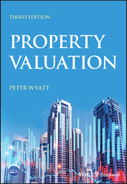Preface
The legal ownership of land and buildings, also known as ‘real property’ and collectively referred to as property throughout this book, confers rights that enable it to be developed, occupied or leased. The physical occupation of property is essential for social and economic activities including shelter, manufacture, commerce, recreation and movement. Typically, physical property ownership is not desired as an end in itself, although a prestigious site or landmark building can confer non‐financial value. Rather, demand for property is a derived demand; occupiers require property to help deliver social and economic activities, and investors require property as an investment asset. This concept of derived demand has a direct bearing on its valuation. The interaction between the supply of and demand for property generates exchange prices and valuations are estimates of those market prices. Valuers interpret the way in which market participants measure and quantify value. Increasingly, there is recognition of value beyond ‘market’ value; referred to as non‐market value. The valuer's skill set has conventionally focused on the estimation of market value but in some cases social and environmental assessments can complement market valuations to ensure that owners, occupiers and other affected parties are aware of and, if appropriate, fairly compensated for any interference with their property rights.
Section A covers valuation principles. Chapter 1 begins with a discussion on property rights and the way in which those rights can confer value to their holders. The chapter ends by explaining how and why valuation has evolved as a discipline to help estimate the value of those property rights. Chapter 2 outlines the economics or property value relevant to property markets and estimates of exchange price. It introduces economic terms and concepts associated with the supply of and demand for property, the concept of rent as a payment for their use and some land‐use theory. It explains how property values arise using economic principles and theories that have been developed and expounded over the past century and a half. Building on the theories relating to the agricultural land market, the causes and spatial distribution of urban land and property uses and rents are described. The chapter examines the economics of supply and demand and the establishment of equilibrium exchange price in the property market and its constituent sectors. The chapter explains the causes of price differentials between land uses. Chapter 3 describes the main property market sectors – occupation, investment and development – and the way that they interact with one another. Chapter 4 explains the mathematics that underpin the valuation methods described in Section B.
Section B covers valuation approaches. It begins with Chapter 5, which describes the valuation process, from confirmation of the instruction to value a property through to the publication of a valuation report. Chapters 6, 7 and 8 explain the valuation methods and techniques that fall under the three internationally recognised approaches to property valuation – market, income and cost. Whichever method is employed, it should reflect the behaviour of market participants. The figure below shows that in active markets, where there is a large quantity of transactions involving properties with similar characteristics, the role of the valuer is essentially to interpret market signals and apply them to the subject property – a comparison approach. With limited availability of market information, market‐valuation methods are increasingly cost‐based. Valuers are required to make more assumptions, and this increases valuation uncertainty.

Using the market approach (Chapter 6), the valuer examines recent market transactions involving comparable properties and uses this market intelligence to help estimate value. The income approach (Chapter 7) considers the net income that a property might generate, typically in the form of rent, and this income can be capitalised to estimate a capital value. Both the rent and the capitalisation rate will be estimated using comparable evidence. For properties where comparable evidence is lacking, the cost approach (Chapter 8) estimates the cost of replacement, perhaps incorporating a depreciation rate for older or less‐functional properties. Building costs, depreciation rates and land values are all estimated by referring to comparable evidence. The cost approach also covers the valuation of development land. The choice of valuation approach depends on the type of property that is to be valued and the purpose of the valuation.
Section C considers the application of these valuation approaches in practice. Chapter 9 examines the valuation of investment properties, where the ownership and use of a property is split so that the occupier pays a rent to the owner, representing the return on the owner's investment. Valuations are required to determine the level of rent that might be charged and the price that an investor might pay when buying or selling a property investment. Chapter 10 covers the valuation of development property, an important and challenging area of valuation work. The valuer is required to estimate the cost of construction and the market value of a development that is hypothetical, since it has not been built yet. This is done so that either the value of development land or development profit can be calculated. Chapter 11 explains how valuations are used in financial statements of companies and public bodies to report the market value of their property assets. The chapter also explains how valuations are relied upon by lenders to assess the value of property that is used as loan security. Most countries have some form of tax that is based on property values so Chapter 12 considers how valuations are undertaken for tax purposes. Similarly, most countries have legislation that allows them to compulsorily acquire property for government purposes. Chapter 13 explains how valuations are central to the assessment of compensation to owners, occupiers and other affected parties. Finally, Chapter 14 reviews the issues of risk, flexibility and uncertainty and the way that they affect valuations.
